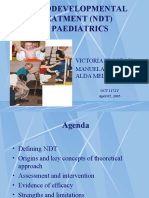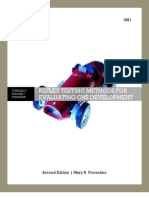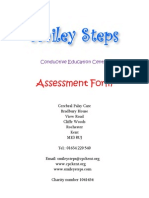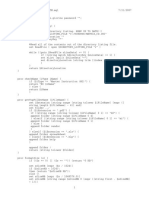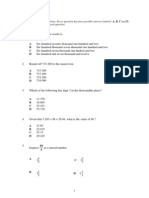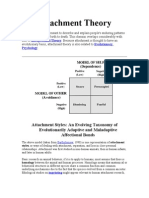Neuro-Developmental Therapy/Treatment: Pediatric Physical Therapy, NDT
Neuro-Developmental Therapy/Treatment: Pediatric Physical Therapy, NDT
Uploaded by
Muhamed Elsayed - ZalatCopyright:
Available Formats
Neuro-Developmental Therapy/Treatment: Pediatric Physical Therapy, NDT
Neuro-Developmental Therapy/Treatment: Pediatric Physical Therapy, NDT
Uploaded by
Muhamed Elsayed - ZalatOriginal Title
Copyright
Available Formats
Share this document
Did you find this document useful?
Is this content inappropriate?
Copyright:
Available Formats
Neuro-Developmental Therapy/Treatment: Pediatric Physical Therapy, NDT
Neuro-Developmental Therapy/Treatment: Pediatric Physical Therapy, NDT
Uploaded by
Muhamed Elsayed - ZalatCopyright:
Available Formats
Pediatric Physical Therapy, NDT
Neuro-developmental Therapy/Treatment
(NDT)
There are a number of approaches developed for the treatment of individuals with
patho-physiology of the central nervous system (CNS). Bobath/NDT (Neuro-Developmental
Therapy) is one of the commonly used approaches in the field of neurological rehabilitation for
the assessment and management of primarily children with cerebral palsy (CP) and adults who
have motor and sensory problems caused by cerebral vascular accidents (CVA)
❖ History of the Bobath Concept
The Bobath/NDT approach was pioneered and developed by Mrs. Berta and Dr. Karl Bobath
in the 1940’s for managing children with CP. Mrs. Bobath always emphasized that her
approach was a “way of thinking” and it was made clear that it “was not a method or
technique, not limiting but fluid, not rigid but changing, and still changing” (Margaret Mayston
2000).
❖ Flow of continuing development of the concept
• INHIBITION OF SPASTICITY – Little movement – Reflex inhibitory postures (RIPs).
Spasticity as seen then: due to abnormal release of spinal and tonic reflexes, due to lack
of inhibitory control of higher centers – therefore can be inhibited.
• Started moving in normal developmental sequences, FACILITATING POSTURAL
REFLEXES (later renamed REACTIONS/RESPONSES) – Reflex inhibitory patterns
• REFLEX INHIBITION in conjunction with FACILITATION through KEY POINTS of
CONTROL. Believed that carry over into function will be automatic.
• Emphasis on TASK ANALYSIS and END FUNCTION. FUNCTIONAL GOAL- setting, involving
client and everybody dealing with the child. Looking beyond therapy to participating in
daily life (using the ICF as framework).
• Changing the term “reflex inhibition patterns” to “tone influencing patterns”
Dr. Mai A. Ahmed, BSU, 2022 Page 1
Pediatric Physical Therapy, NDT
The core of the Bobath/NDT approach was and still is – observing, problem solving and
analyzing the child’s / clients’ abilities, difficulties, personal characteristics, cognitive abilities
and environmental constraints – affecting performance and participation.
The concept is based on the understanding of the dynamic interaction between pathology
and all aspects of development and the relationship between tone and the quality of
movement, and postural control and coordination.
Current views influencing the Bobath approach
The concept is not limiting, but fluid, not rigid, but changing and is still changing (MJ. Mayston,
2001).
• NDT moved from reflex / hierarchical model to DISTRIBUTED CONTROL MODEL. It accepts
the nervous system as being capable of initiating, anticipating and controlling movement.
The CNS is no longer viewed as a passive system controlled by sensory feedback.
FEEDFORWARD as well as FEEDBACK MECHANISMS are utilized.
• CNS is highly TASK ORIENTED in its organization. Postural adjustments / reactions are task
or context dependent. “The function must be PRACTISED IN THE CORRECT CONTEXT”
(Mayston, 2001). Practice of functional goals with new movement patterns, can develop
new MOTOR PROGRAMMES (Bly, 1991).
The self-determination in goal setting and attention to the MOTOR LEARNING process is
more likely to ensure functional changes in everyday life. The interaction of the three
primary SENSORY SYSTEMS (vestibular, visual and somatosensory) in the FEEDFORWARD
mechanism is important for postural adjustments. Determine whether the child’s poor
postural adjustment are due to sensory organization problems and/or muscle coordination
problems.
Neuro-developmental therapy (NDT) is a problem-solving approach focusing on the
individual’s current needs while aiming for the long-term goal of function all over the life. NDT
can be used by occupational, speech, and physical therapists as well as educators. Utilizing
NDT improve the capability to perform functional activities suitable to the individual needs,
active participation of the child, improved flexibility, alignment, and strength, and improved
function across the life. It is not a restricted treatment for CP.
Therapeutic handling is basic to the NDT approach. It is a vital tool in both examination
and treatment. Therapeutic handling helps the therapist to feel the child's response to
Dr. Mai A. Ahmed, BSU, 2022 Page 2
Pediatric Physical Therapy, NDT
disturbances in posture or movement, facilitates postural control and movement synergies that
widen the child's opportunities for selecting successful actions, affords limitations for
movements that distract from the target, and limits or restricts abnormal movement patterns
which lead to secondary deformities, further disability, or decreased participation in society.
Assessing, reassessing and evaluating outcomes, is seen as leading to a better
understanding of the child’s participation restrictions (Sarah Capelovitch 2005).
NDT assessment principles:
✓ What can child do/not do? (activity limitations)
✓ How does he do it? (performance)
✓ What interferes? (primary & secondary impairment)
✓ What can I do? (treatment & management)
✓ Carry-over (family + life)
NDT currently works within the framework of the ICF
❖ FEATURES OF THE APPROACH
✓ Specific preparation for specific function
✓ Handling techniques (tone reduction, facilitation, stimulation) aim for specific
preparation for more normal activity to give possibility for performing more functional
tasks
✓ Use of Tone Influencing Patterns (TIPs) to modify abnormal postural tone
✓ Using Key Points of control (KPC),
*facilitating more normal patterns of movements and
*stimulating more normal voluntary, task oriented patterns.
NB: These techniques alone do not constitute NDT
✓ The “techniques” guide the client, and the resulting movements tell us quite a bit about
what is lacking and what he can achieve
Aims of treatment
• To influence muscle tone and improve postural alignment through specific handling
techniques
• Work for better active participation and practice of specific, relevant, functional skills
Dr. Mai A. Ahmed, BSU, 2022 Page 3
Pediatric Physical Therapy, NDT
Sarah Capelovitch, 2005; 2007
The core of the Bobath/NDT approach was and still is – observing, problem solving and
analyzing the child’s / clients' abilities, difficulties, personal characteristics, cognitive
abilities and environmental constraints – affecting performance and participation.
Considerations of environmental / community factors and participation
Assessing, reasoning and evaluating outcome, are seen as leading to a better
understanding of the child’s participation restrictions
Specific preparation for specific tasks.
Activating the child within the task.
Reducing hands on.
More environmental considerations.
Ensuring carry-over into the real world.
Use of evidence based clinical reasoning rather than theoretical assumptions.
Use of ICF as framework
Use of standardized assessments along with observation in natural settings as much as
possible.
Setting realistic measurable goals with child and family.
❖ Principles of movement facilitation based on NDT principles:
(I) State regulation & stress signs:
-Therapists should be aware of stress signs of children that indicate that the baby is not
functioning optimally and have difficulty to learn the movement that you teach. Stress also
determines the baby’s health and well-being.
-Crying is the most obvious stress sign
-Others: changes in respiratory pattern, coughing, color changes such as cyanosis, temperature
changes, tremors & seizure …….
-When the baby is organized and not stressed, the baby’s state and attention systems are stable
and can move and interact with environment.
-The baby communicates pleasure through smiles, eye contact, pleasant vocalizations, regulated
breathing, stable color, and smooth participation with the activity.
Dr. Mai A. Ahmed, BSU, 2022 Page 4
Pediatric Physical Therapy, NDT
(II) Sensory issues:
-Sensory feedback is needed to learn, regulate & adapt our movements. When sensory
information coordinates with the motor system, we can make postural adjustments, perform
movement, and learn and use motor skills.
-So, sensory input and feedback play a vital role in a baby’s motor development. As the baby
receives sensory information from visual, vestibular and somatosensory (tactile, proprioceptive,
kinesthetic) systems, it is integrated with the motor system and enables the baby to adjust (right)
the head, body, and limbs in space and in relation to each other and gravity. The baby rights
head and trunk with extension in prone, flexes head and trunk in supine and laterally flexes
them in side lying. In sitting and standing, the baby rights the head and trunk with extension
when COM shifts forward, with flexion when COM shifts backward and laterally when COM
shifts laterally.
-Once the baby experienced and practices such movement and postural reactions, the baby
learns to anticipate the need for the postural adjustments and subsequently makes postural
adjustments before the actual movement occurs. These adjustments (movements the baby
makes in anticipation of the requirements and prior to sensory feedback) are called
“feedforward”.
-So we learn movements and postural adjustments through feedback and we then perform them
with feedforward. We usually use feedforward in our “automatic” movements. The baby must
be able to receive, regulate and adapt to this input (feedback) to develop and perform optimally
(feedforward).
-Children with sensory system impairments may learn, practice and use compensatory or
stereotyped movements habitually through feedforward. Small motor compensations early in
development can lead to major motor-related problems in later life. Some children with motor
problems have difficulty with reception, regulation and/or adaptation to sensory stimuli. Some
have “hyper” responses and others have “hypo” responses. Early detection and treatment of
sensory impairments are important.
-For example, a child with head lag during pull to sit, how we can differentiate between
contribution of sensory problem with the motor problem or not? We can just look at facial
expressions, if the child doesn’t seem to be stressed with head in this position, the child may be
unaware that head isn’t in the optimal position which may reflects inability to receive or process
feedback that head isn’t in the optimal position. So we have to enhance sensory feedback in
conjunction with motor response. In contrast, if child is stressed, so his sensory feedback may
be appropriate but the motor control may be ineffective to respond. So we have to integrate
motor control with the sensory feedback.
Dr. Mai A. Ahmed, BSU, 2022 Page 5
Pediatric Physical Therapy, NDT
Sensory
Feedback
Intrinsic Extrinsic
Vision Vestibular Somatosensory
Tactile Proprioceptive Kinesthetic
Vision:
to orient eyes to horizon
to gain sense of upright
to interact with people
Vestibular: for orientation of all planes of movements. It is affected by movement during
facilitation, varied child positions, speed & direction of movement.
Somatosensory: affected by tactile (therapists, equipment), proprioceptive & kinesthetic input
through WB, weight shifting, guided & active movements that used in all facilitatory
techniques.
Facilitation of the child’s movements may be more successful if sensory issues
are treated first
Extrinsic sensory feedback:
Comes from placement & movement of therapist hands / body, speed of movement, shape /
firmness & texture of equipment, visual & auditory environment ……….So it is under our
control
Dr. Mai A. Ahmed, BSU, 2022 Page 6
Pediatric Physical Therapy, NDT
(III) Kinesiological issues:
ROM
Alignment BOS
3 planes
ROM
Initially facilitate the child through available partial range, the child Never be forced
into full range
Range will increase with practice. If not, never force but adapt on available range
Alignment
It is one of the most important issues in facilitation
Body functions are the best when each segment is properly aligned
If one segment is out of alignment, the superior / inferior segments will compensate /
adapt
It is important to observe body alignment (from 3 planes) before facilitation then try to
align child as close to neutral
Child that is poorly aligned, it will be difficult to proceed with the facilitation and if
facilitation is continued, child will use compensatory patterns
Dr. Mai A. Ahmed, BSU, 2022 Page 7
Pediatric Physical Therapy, NDT
BOS
Alignment of BOS influences all superior structures
Prone position: for example if hip is flexed in this position, this will limit hip extension
and definite will shift COM toward the head and limit head lifting. Another example if
ULs or LLs are excessively abducted, that will also disturb weight shifting from side to
other.
Bench or bolster sitting: if pelvis is not aligned for example if pelvis is tilted anteriorly,
that will shift COM forward and child will compensate with lumbar hyper-lordosis while
if pelvis tilted posteriorly, COM will shifted backward and child will compensate with
excessive kyphosis.
Floor sitting (long sitting, ring sitting, W sitting, side sitting)
Quadruped
Kneeling
Standing
Movement in all three planes
Movement in all three planes; sagittal, frontal and transverse allows fluid movement
Human movement is fluid & efficient because of synchronization between & within
muscle groups; muscles work in synergies agonist/antagonist…..concentric/eccentric
Muscles should be elongated to work efficiently: elongation of the muscles must be
followed with activation of the muscles in functional patterns
Sagittal plane:
-Children with neurological problems often over employ movements in this plane and develop
tightness in the muscles used
-Facilitation techniques used in that plane to alternately elongate & activate flexors &
extensors muscles and alternate between con & eccentric muscle activity (Example: sit to stand
& vice versa)
Ex. Try to reach above shoulder level with pelvis tilted anteriorly then posteriorly and notice the
range of shoulder elevation…..
Dr. Mai A. Ahmed, BSU, 2022 Page 8
Pediatric Physical Therapy, NDT
Frontal plane:
-Children with neurological problem have difficulty to move in that plane with control
-Facilitation designed to balance between flexors & extensors of the trunk to start moving in
frontal plane (example: lateral weight shift from sitting, from kneeling to half kneeling)
Ex. Facilitate UL response as a protection laterally (with / without lateral weight shift)
Transverse plane:
-Children with neurological problems usually have difficulty moving on this plane.
-Facilitation on this plane is designed to increase joint & soft tissue mobility, to diagonally
activate & coordinate upper & lower trunk muscles and to balance concentric & eccentric
activity of these muscles
-Transverse plane movements are the last to emerge in development & the first to be lost in
disability
-Movements in that plane affect muscles that move on both sagittal & frontal planes so they are
effective for gaining mobility & control
-Trunk rotation must include continuous rotation of entire spine so that the pelvis rotates over
the WB femur.
(IV) Role of developmental sequence:
Model/reference for therapeutic intervention (quality as well as quantity).
You must be familiar with developmental sequence not to follow but to establish age-
appropriate goals for each condition
Past-present-future philosophy (example: 7 months baby with problem in weight shifting
from sitting)
(V) Therapist’s facilitation:
Your hands:
-Facilitation is “hands on” approach to assist the child
-Therapist places hands on specific parts of the child’s body to help to align body segment, to
stabilize body segments and/or prevent movement of a segment
Dr. Mai A. Ahmed, BSU, 2022 Page 9
Pediatric Physical Therapy, NDT
Sensory effect of therapist’s hands:
They convey & receive information
So they must be respectfully, carefully & purposefully placed on child’s body.
They should shape to the contour not grab onto child’s body
Palms provide much control for movement, don’t use tip of fingers.
They must never cause discomfort, not push, pull or lift the child
Need practice to gradually become more relaxed
After practice, hands receive more information from the child (muscle contraction,
relaxation, little tension when he becomes fearful from moving too far or too fast to
modify the technique
That makes child develops more trust in the therapist
Changing pressure & control of therapist hands
Child must be active participant
So therapist hands are gradually withdrawn → so child takes over more of the control
(motor learning)
Place of hands:
Hands over joints (to facilitate glutes not holding pelvis)
Example: from kneeling to half kneeling
Hands over muscles
Example: from quadruped to kneeling
Hands on proximal joints
Provide stability or mobility according to the situation
Both achieved during facilitation of sequence of movement
Hands on distal joints
When the child has some proximal control
(Slow careful traction to extremities)
N.B: The goal for the child is to learn to move independently, not to perform the
movement perfectly
Dr. Mai A. Ahmed, BSU, 2022 Page 10
Pediatric Physical Therapy, NDT
Independent movement involves:
✓ Making mistakes
✓ Detecting mistakes
✓ Understanding sequence of mistakes
✓ Trying to problem-solve how to correct mistakes
Example: Allow the child to fall but protects him from injury by actually controlling the fall
(VI) Synchronous movement with another individual:
Facilitation like a “dance”
One person leading but not overpowering other one
Therapist hands & body must move with the child
If therapist remains stationary when the child tries to move, movement will be blocked
Therapist must be aware of his own movements & movement compensations
Therapist’s physical strength will influence the facilitation technique as he need enough
strength to guide, support & protect the child throughout the technique
✓ Use proper body mechanics
✓ The primary concern is safety for both
If the same hand is always the guiding hand, therapist will work only on one side of the
child
Therapist asymmetry affects flow of facilitation, as the child may develop the same
asymmetry.
Therapist may adapt each technique to meet restrictions of his own body size, strength,
orthopedic needs & comfort with techniques
(VII) Speed of movement:
It is recommended that techniques be facilitated at various speed
So it is important to monitor child’s response to the speed
The rhythm of movement: should be varied to allow the child
✓ To learn to vary his movements and
✓ To learn to adapt to changes
Dr. Mai A. Ahmed, BSU, 2022 Page 11
Pediatric Physical Therapy, NDT
(VIII) Play:
It is the functional activity of the child
Motivates the child to move & learn new movement strategies
All facilitatory techniques needed to be practiced in the context of play
Choose age-appropriate toys (level of playing)
Baby who is not interested in play or doesn’t know how to play often is not motivated
to move
Development of play skills is an important treatment goal
(IX) Equipment:
Your body (small baby)
Balls
Bolster
Bench
When u select an equipment, consider u can manage both equipment & baby
(X) The family:
The most important people on the baby’s team
You must address family’s needs, support, encourage them, educate & teach them about
child’s strengths as well as needs
Involve them in planning treatment program, setting goals for home
Dr. Mai A. Ahmed, BSU, 2022 Page 12
Pediatric Physical Therapy, NDT
❖ Components of movement
Alignment
Mobility Stability
Weight Weight
bearing shifting
Dissociation
References
Bly, L., (2008): Baby Treatment Based on NDT Principles, Therapy Skill Builders.
Bly L., (1997): Facilitation techniques based on NDT principles, Therapy Skill Builders.
Howle, J., (2007): Neuro-Developmental Treatment Approach Theoretical Foundations
and Principles of Clinical Practice (3rd ed), North American NDT Association.
Mayston, M., (2001): People with cerebral palsy: effects of and perspective for therapy,
Neural plasticity; 8, 51-69.
International Classification of Functioning, Disability and Health.
Special thanks for Mrs. Estelle Brown, SANDTA Tutor and Mrs. Miriam Pollitt, NDT
Bobath Tutor.
Dr. Mai A. Ahmed, BSU, 2022 Page 13
You might also like
- The Secret CovenantDocument9 pagesThe Secret CovenantG. D3MON3AT3R94% (16)
- Gross Motor Function Measure (GMFM-66 & GMFM-88) User’s Manual: 3rd EditionFrom EverandGross Motor Function Measure (GMFM-66 & GMFM-88) User’s Manual: 3rd EditionNo ratings yet
- Pediatric Evaluation of Disability Inventory SUMMARYDocument4 pagesPediatric Evaluation of Disability Inventory SUMMARYFaye ValensoyNo ratings yet
- Cerebral Palsy AssessmentDocument6 pagesCerebral Palsy AssessmentdrprasantNo ratings yet
- Dynamic Gait Index: (Original 8-Item Test)Document2 pagesDynamic Gait Index: (Original 8-Item Test)Gustavo Cabanas0% (1)
- Bobath Approach: Neuro-Developmental TechniquesDocument25 pagesBobath Approach: Neuro-Developmental TechniquesJAZA RIZVI100% (2)
- Introduction To Theories of Neurological RehabilitationDocument30 pagesIntroduction To Theories of Neurological RehabilitationHibaAli80% (5)
- Burnstrom, MRP Approaches For Neurological ConditionsDocument68 pagesBurnstrom, MRP Approaches For Neurological ConditionsSaba IqbalNo ratings yet
- Bobath Approach Concepts and Principles: by DR - Shahid Shabbir DPT, Ms - NMPTDocument21 pagesBobath Approach Concepts and Principles: by DR - Shahid Shabbir DPT, Ms - NMPTrabia khalid100% (2)
- Pediatric Assessment&screening ToolsDocument7 pagesPediatric Assessment&screening Toolsdariand100% (1)
- Spatiotemporal Adaptation Frame of ReferenceDocument10 pagesSpatiotemporal Adaptation Frame of ReferenceKevin Parnala100% (2)
- Clinical Observations of Motor and Postural Skills-2 Edition (COMPS-2)Document16 pagesClinical Observations of Motor and Postural Skills-2 Edition (COMPS-2)Jhon Liev100% (3)
- Neurodevelopment TechniqueDocument64 pagesNeurodevelopment Techniquenishitpatel2002100% (5)
- Emdr Final DraftDocument15 pagesEmdr Final Draftapi-506581034No ratings yet
- NDT FinalDocument8 pagesNDT Finalapi-228136529No ratings yet
- Neuro Developmental Treatment (NDT) : Prepared By: Akhi Mony Clinical Physiotherapist (CPT) CRP-MirpurDocument24 pagesNeuro Developmental Treatment (NDT) : Prepared By: Akhi Mony Clinical Physiotherapist (CPT) CRP-MirpurAkhi MonyNo ratings yet
- Neurodevelopmental Treatment (NDT) in Paediatrics: Victoria Prooday Manuela Ocrainschi Alda MeloDocument36 pagesNeurodevelopmental Treatment (NDT) in Paediatrics: Victoria Prooday Manuela Ocrainschi Alda MeloDnyanesh Patil100% (1)
- Rehabilitation Priciples at Children With Cerebral Palsy After NDT Bobath ConceptDocument13 pagesRehabilitation Priciples at Children With Cerebral Palsy After NDT Bobath ConceptAndrei TîrziuNo ratings yet
- Bobath Approach NotesDocument5 pagesBobath Approach NotesJuling Perales100% (6)
- Rood Approach: Ot Ead 322: Traditional Sensorimotor ApproachesDocument3 pagesRood Approach: Ot Ead 322: Traditional Sensorimotor ApproachesShekinah Gracia T. Mosquera100% (2)
- NDTDocument9 pagesNDTKhaing Hsu WaiNo ratings yet
- Neuro-Developmental TechniqueDocument15 pagesNeuro-Developmental Techniqueapi-442568656100% (1)
- Tone Assessment Tools 07-01Document41 pagesTone Assessment Tools 07-01Pranay MallNo ratings yet
- Thera Neuromotor Approaches NirDocument10 pagesThera Neuromotor Approaches NirCeline Kyla Mallo100% (1)
- New Roods ApprochDocument50 pagesNew Roods ApprochMonicca GV100% (1)
- Dr. Maheshwari Harishchandre Assistant Professor M.P.TH (Neurosciences)Document46 pagesDr. Maheshwari Harishchandre Assistant Professor M.P.TH (Neurosciences)Nikks Borade100% (1)
- Application of Bobath COnceptDocument61 pagesApplication of Bobath COnceptArun Kumar PT100% (3)
- Remediating Motor ControlDocument66 pagesRemediating Motor Controlhis.thunder122100% (3)
- Sensory-Motor Development in The First Year: By:Yohannes PurwantoDocument39 pagesSensory-Motor Development in The First Year: By:Yohannes PurwantoAndrew Aland100% (3)
- Brunnstrom ApproachDocument26 pagesBrunnstrom ApproachMohaChebiNo ratings yet
- Paediatric Physiotherapy Involves The AssessmentDocument2 pagesPaediatric Physiotherapy Involves The AssessmentL RNo ratings yet
- The Rood Approach TheraExDocument8 pagesThe Rood Approach TheraExLall Jingerppang100% (1)
- Bigjthera Rood - S TechniqueDocument51 pagesBigjthera Rood - S Techniquekim100% (1)
- Adl Re EducationDocument28 pagesAdl Re Educationpsycin100% (1)
- Cerebral Palsy Assessment Form: History: VisionDocument16 pagesCerebral Palsy Assessment Form: History: VisionRupam KanungoNo ratings yet
- Vojta TherapyDocument4 pagesVojta TherapyPrashu Jain100% (1)
- Roods ApproachDocument33 pagesRoods ApproachCedricFernandez100% (1)
- Bobath ApproachDocument22 pagesBobath ApproachCedricFernandez50% (4)
- Reflex Testing Method For Evaluating CNS DevelopmentDocument55 pagesReflex Testing Method For Evaluating CNS DevelopmentPJHG100% (6)
- Vojta Therapy: Reflex Creeping in A Prone Lying Position and Reflex Rolling From A Supine and Side LyingDocument7 pagesVojta Therapy: Reflex Creeping in A Prone Lying Position and Reflex Rolling From A Supine and Side LyingSonali SoumyashreeNo ratings yet
- Roods ApproachDocument23 pagesRoods Approachyigo100% (1)
- NDTDocument30 pagesNDTSenthil Kumar100% (2)
- Physiotherapy Assessment and Treatment On PICUDocument54 pagesPhysiotherapy Assessment and Treatment On PICUBatool Rehman100% (3)
- Mobility and Functional Assessment ToolsDocument4 pagesMobility and Functional Assessment Toolssonya63265No ratings yet
- Introduction To Cerebral PalsyDocument23 pagesIntroduction To Cerebral PalsyVenkata Nagaraj Mummadisetty100% (1)
- Presented by - Rutuja Suryawanshi Roll No.:-34 Batch: - Summer 2020-21 Date of Presentation: - 1/5/2021Document41 pagesPresented by - Rutuja Suryawanshi Roll No.:-34 Batch: - Summer 2020-21 Date of Presentation: - 1/5/2021Anurag SuryawanshiNo ratings yet
- Assessment Form CPDocument13 pagesAssessment Form CPvmsvino100% (2)
- ApproachDocument37 pagesApproachAshu AshNo ratings yet
- 892 Physiotherapy Management of Paediatric Flat FeetDocument20 pages892 Physiotherapy Management of Paediatric Flat FeetCalvina Mizumi100% (1)
- Gait Analysis PresentationDocument41 pagesGait Analysis PresentationKýñg Butler100% (1)
- Neuromuscular Disorders in Geriatric PatientsDocument16 pagesNeuromuscular Disorders in Geriatric PatientsAhmed NasrNo ratings yet
- Neuro Developmental Treatment (NDT) For Cerebral Palsy: - A Clinical StudyDocument2 pagesNeuro Developmental Treatment (NDT) For Cerebral Palsy: - A Clinical StudyInternational Journal of Innovative Science and Research TechnologyNo ratings yet
- Navicular Drop Test ProtocolDocument8 pagesNavicular Drop Test ProtocolNiken Dwi SaraswatiNo ratings yet
- OrthosisDocument112 pagesOrthosisChandan MahapatraNo ratings yet
- Constraint Induced Movement Therapy CIMTDocument22 pagesConstraint Induced Movement Therapy CIMTAniqa AsgharNo ratings yet
- ROOD ApproachDocument59 pagesROOD Approachsridhar_physio80% (5)
- VojitaDocument19 pagesVojitaShemjaz ArakkalNo ratings yet
- Neurological Assessment in the First Two Years of LifeFrom EverandNeurological Assessment in the First Two Years of LifeGiovanni CioniNo ratings yet
- Movement Difficulties in Developmental Disorders: Practical Guidelines for Assessment and ManagementFrom EverandMovement Difficulties in Developmental Disorders: Practical Guidelines for Assessment and ManagementNo ratings yet
- October 1 SS - SLD - 2022Document1 pageOctober 1 SS - SLD - 2022Muhamed Elsayed - ZalatNo ratings yet
- LVDocument43 pagesLVMuhamed Elsayed - ZalatNo ratings yet
- Rel B0 To XML83 SOTMDocument9 pagesRel B0 To XML83 SOTMMuhamed Elsayed - ZalatNo ratings yet
- 42074-Omranya C SLDDocument1 page42074-Omranya C SLDMuhamed Elsayed - ZalatNo ratings yet
- setPDFTitle 7Document2 pagessetPDFTitle 7Muhamed Elsayed - Zalat100% (1)
- Hvac QuestionDocument12 pagesHvac QuestionMuhamed Elsayed - ZalatNo ratings yet
- Standarisasi Kode Klasifikasi Diagnosa Dan Terminologi Dan Terminologi Uptd Puskesmas Cidahu Berdasarkan Icd XDocument7 pagesStandarisasi Kode Klasifikasi Diagnosa Dan Terminologi Dan Terminologi Uptd Puskesmas Cidahu Berdasarkan Icd XAna KhasanahNo ratings yet
- Tpo Ward BMDocument3 pagesTpo Ward BMAhl A PurujiNo ratings yet
- Reported SpeechDocument11 pagesReported SpeechHongminhNo ratings yet
- StatisticaDocument40 pagesStatisticastephennrobertNo ratings yet
- Semiconductors Short Notes in The Form ofDocument58 pagesSemiconductors Short Notes in The Form ofadi_risingsun0% (1)
- Mode of Action of An Ayurvedic Preparation in Relieving Sign and Symptoms of Madatya: A Conceptual StudyDocument7 pagesMode of Action of An Ayurvedic Preparation in Relieving Sign and Symptoms of Madatya: A Conceptual StudySatbir ChoudharyNo ratings yet
- SantacruzanDocument7 pagesSantacruzanJLOUIENo ratings yet
- Chapter 2: Signal Representation: ELEC 2880: Modem DesignDocument18 pagesChapter 2: Signal Representation: ELEC 2880: Modem DesignSuvra DasNo ratings yet
- AB Agenda Pack PDFDocument160 pagesAB Agenda Pack PDFAngengNo ratings yet
- HGPQ2L2 - My Journey To A Stronger MeDocument9 pagesHGPQ2L2 - My Journey To A Stronger MeRico PalmaNo ratings yet
- DolphinDocument37 pagesDolphinalamingazi6381No ratings yet
- A B C D: Choose Only One Answer For Each QuestionDocument10 pagesA B C D: Choose Only One Answer For Each QuestionAchitt AchitNo ratings yet
- Courage and Character, Leaders and Legends: An Interview With Richard LowerDocument2 pagesCourage and Character, Leaders and Legends: An Interview With Richard LowerAli RajaNo ratings yet
- Attachment TheoryDocument4 pagesAttachment TheoryMohamad Shuhmy Shuib100% (2)
- Logistic RegressionDocument47 pagesLogistic Regressionfatina92100% (2)
- Zohar and Iamblichus: Ehuda IebesDocument6 pagesZohar and Iamblichus: Ehuda IebesDamean SamuelNo ratings yet
- Weekly Home Learning Plan PEDocument8 pagesWeekly Home Learning Plan PEEdmar PenuelaNo ratings yet
- Week 2 Covid-19 La Lesson PlanDocument2 pagesWeek 2 Covid-19 La Lesson Planapi-533472774No ratings yet
- Gender Equality and Women Representation in GovernanceDocument16 pagesGender Equality and Women Representation in GovernanceAbasiNo ratings yet
- Chua v. Cabangbang, 27 SCRA 791Document8 pagesChua v. Cabangbang, 27 SCRA 791JenNo ratings yet
- Audi A4 1.8T Ultimate Timing Belt Kit Installation Guide ES#8146Document15 pagesAudi A4 1.8T Ultimate Timing Belt Kit Installation Guide ES#8146Vasile AdrianNo ratings yet
- Discipline of Lawyers-Discipline of Fil Lawyers Abroad-Reinstatement After DisbarmentDocument45 pagesDiscipline of Lawyers-Discipline of Fil Lawyers Abroad-Reinstatement After DisbarmentMary Therese Gabrielle Estioko100% (1)
- Measurement 2Document11 pagesMeasurement 2mraciaydinNo ratings yet
- Block Diagram of Digital ComputerDocument25 pagesBlock Diagram of Digital ComputerVikram ComputerInstituteNo ratings yet
- Research PaperDocument10 pagesResearch PaperSujeet KawdeNo ratings yet
- Tutorial 1-Solid State Physics-2010Document3 pagesTutorial 1-Solid State Physics-2010Woon Bing100% (1)
- Self Learning-Luis 09/07: "Autodidact" "Self-Taught" "Self-Taught Learner"Document2 pagesSelf Learning-Luis 09/07: "Autodidact" "Self-Taught" "Self-Taught Learner"PACONo ratings yet
- ICOMOS WHThematicStudy SilkRoads Final LV 201406Document164 pagesICOMOS WHThematicStudy SilkRoads Final LV 201406Anuj PratapNo ratings yet


















